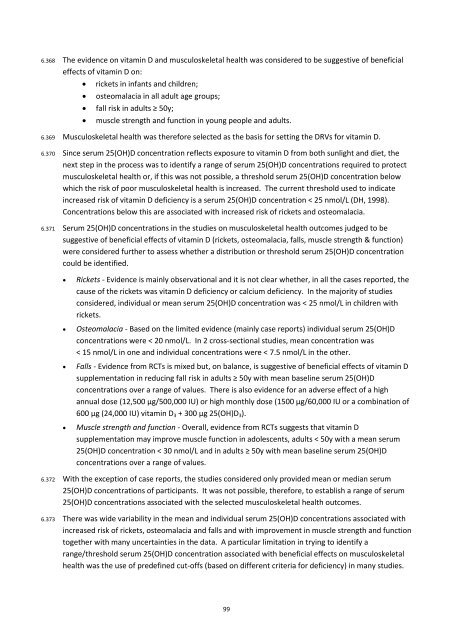Vitamin D and Health
SACN_Vitamin_D_and_Health_report
SACN_Vitamin_D_and_Health_report
You also want an ePaper? Increase the reach of your titles
YUMPU automatically turns print PDFs into web optimized ePapers that Google loves.
6.368 The evidence on vitamin D <strong>and</strong> musculoskeletal health was considered to be suggestive of beneficial<br />
effects of vitamin D on:<br />
<br />
<br />
rickets in infants <strong>and</strong> children;<br />
osteomalacia in all adult age groups;<br />
fall risk in adults ≥ 50y;<br />
<br />
muscle strength <strong>and</strong> function in young people <strong>and</strong> adults.<br />
6.369 Musculoskeletal health was therefore selected as the basis for setting the DRVs for vitamin D.<br />
6.370 Since serum 25(OH)D concentration reflects exposure to vitamin D from both sunlight <strong>and</strong> diet, the<br />
next step in the process was to identify a range of serum 25(OH)D concentrations required to protect<br />
musculoskeletal health or, if this was not possible, a threshold serum 25(OH)D concentration below<br />
which the risk of poor musculoskeletal health is increased. The current threshold used to indicate<br />
increased risk of vitamin D deficiency is a serum 25(OH)D concentration < 25 nmol/L (DH, 1998).<br />
Concentrations below this are associated with increased risk of rickets <strong>and</strong> osteomalacia.<br />
6.371 Serum 25(OH)D concentrations in the studies on musculoskeletal health outcomes judged to be<br />
suggestive of beneficial effects of vitamin D (rickets, osteomalacia, falls, muscle strength & function)<br />
were considered further to assess whether a distribution or threshold serum 25(OH)D concentration<br />
could be identified.<br />
<br />
<br />
<br />
<br />
Rickets - Evidence is mainly observational <strong>and</strong> it is not clear whether, in all the cases reported, the<br />
cause of the rickets was vitamin D deficiency or calcium deficiency. In the majority of studies<br />
considered, individual or mean serum 25(OH)D concentration was < 25 nmol/L in children with<br />
rickets.<br />
Osteomalacia - Based on the limited evidence (mainly case reports) individual serum 25(OH)D<br />
concentrations were < 20 nmol/L. In 2 cross-sectional studies, mean concentration was<br />
< 15 nmol/L in one <strong>and</strong> individual concentrations were < 7.5 nmol/L in the other.<br />
Falls - Evidence from RCTs is mixed but, on balance, is suggestive of beneficial effects of vitamin D<br />
supplementation in reducing fall risk in adults ≥ 50y with mean baseline serum 25(OH)D<br />
concentrations over a range of values. There is also evidence for an adverse effect of a high<br />
annual dose (12,500 µg/500,000 IU) or high monthly dose (1500 µg/60,000 IU or a combination of<br />
600 µg (24,000 IU) vitamin D 3 + 300 µg 25(OH)D 3 ).<br />
Muscle strength <strong>and</strong> function - Overall, evidence from RCTs suggests that vitamin D<br />
supplementation may improve muscle function in adolescents, adults < 50y with a mean serum<br />
25(OH)D concentration < 30 nmol/L <strong>and</strong> in adults ≥ 50y with mean baseline serum 25(OH)D<br />
concentrations over a range of values.<br />
6.372 With the exception of case reports, the studies considered only provided mean or median serum<br />
25(OH)D concentrations of participants. It was not possible, therefore, to establish a range of serum<br />
25(OH)D concentrations associated with the selected musculoskeletal health outcomes.<br />
6.373 There was wide variability in the mean <strong>and</strong> individual serum 25(OH)D concentrations associated with<br />
increased risk of rickets, osteomalacia <strong>and</strong> falls <strong>and</strong> with improvement in muscle strength <strong>and</strong> function<br />
together with many uncertainties in the data. A particular limitation in trying to identify a<br />
range/threshold serum 25(OH)D concentration associated with beneficial effects on musculoskeletal<br />
health was the use of predefined cut-offs (based on different criteria for deficiency) in many studies.<br />
99


